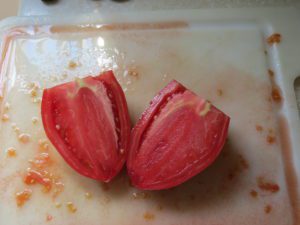Growing tomatoes

Tomatoes have got to be a vegetable gardener’s favorite crop! I mean, you just can’t beat the flavor of a homegrown tomato, right? Now that we’re into the middle of May, it’s time to plant these gems. I just filmed a video on growing tomatoes. Take a look:
More thoughts on growing tomatoes
In the video, I mentioned two types of tomato plant supports. They are concrete-reinforcing wire panels or heavy-duty tomato cages made from field fence. Another excellent material to use, which will last forever, is a cattle panel. They are super durable and galvanized so they won’t rust. So if you’re going to build your own tomato cages, consider that for a material as well.
When it comes to supporting your plants with concrete-reinforcing wire or cattle panels, you can just “weave” the plants in and out of the wire grids as they grow. I meant to mention this in my video but forgot. I also use some jute twine to provide extra support to the plants. You certainly wouldn’t want them to be whipping around in a windstorm.
I also discussed fertilizing tomato plants with an organic fertilizer high in phosphorus (the middle number on fertilizer packages). Phosphorus is so helpful for vegetable plants that need to bloom and set fruit, so this would also apply to eggplants, peppers, melons, cucumbers, pumpkins, and summer and winter squash. Did you know that phosphorus also helps root crops? So organic soil amendments such as bone meal should be in your arsenal!
I started my tomato plants from seed, and once they had their true leaves, they were given diluted fish fertilizer which is high in nitrogen. This helped them get off to a good start. It’s OK to give them fish fertilizer every couple of weeks for the first 6 weeks or so, but then you want to switch to a high-phosphorus fertilizer.
Another tidbit I wanted to share with you is the importance of calcium in the soil of your tomato bed. As you are probably aware, tomatoes can have problems with blossom-end rot. This is from a calcium deficiency, and typically occurs if the plants are watered irregularly. So there are two things you can do about this: 1) be sure to water your garden on a regular basis to keep plants from drying out, and 2) you can add some pelletized calcium to your soil before planting your tomato seedlings. You can find calcium at well-stocked garden centers, but I’ve included a link to it on the Gardens Alive! website just to give you a starting point.
If you didn’t catch the names of the paste tomatoes I’m growing in the video, they are ‘Amish Paste – Kapuler’ and ‘Italian Pompeii’. I grew the ‘Amish Paste – Kapuler’ last summer and they were huge so they get the lion’s share of the bed this year!
One other thing… be sure to watch the weather forecasts closely. Sometimes Mother Nature likes to pull a fast one on us by sneaking in a frost when you least expect it. Be prepared to cover them for the next couple of weeks, just in case.
As always, if you have any questions, please drop me a note at Susan@susansinthegarden.com. Happy gardening!

